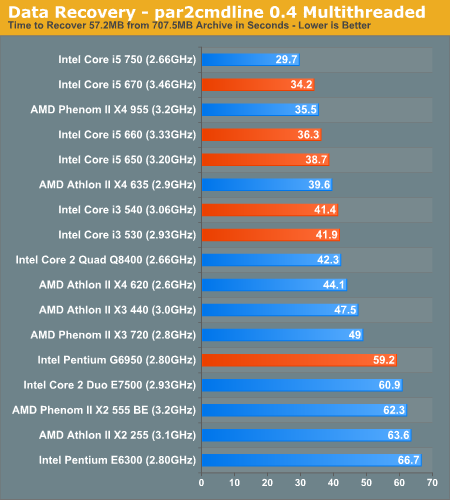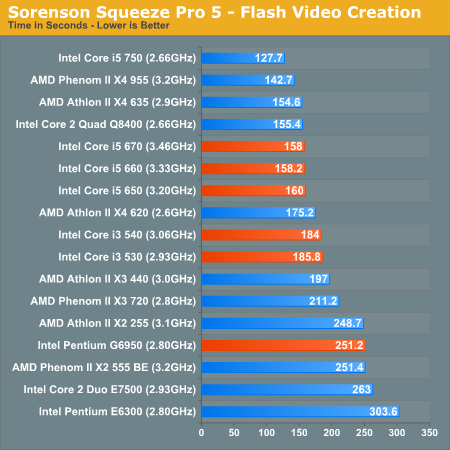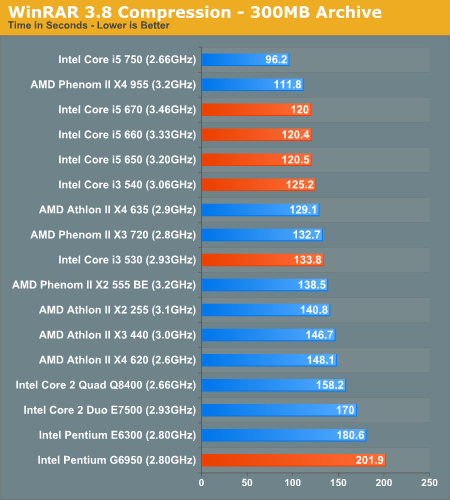The Rest of Clarkdale: Intel's Pentium G6950 & Core i5 650/660/670 Reviewed
by Anand Lal Shimpi on March 24, 2010 4:00 PM EST- Posted in
- CPUs
PAR2 Multithreaded Archive Recovery Performance
Par2 is an application used for reconstructing downloaded archives. It can generate parity data from a given archive and later use it to recover the archive
Chuchusoft took the source code of par2cmdline 0.4 and parallelized it using Intel’s Threading Building Blocks 2.1. The result is a version of par2cmdline that can spawn multiple threads to repair par2 archives. For this test we took a 708MB archive, corrupted nearly 60MB of it, and used the multithreaded par2cmdline to recover it. The scores reported are the repair and recover time in seconds.

Our Par2 test scales very well with core and thread count, which is why the Core i5 750 does so very well here. The Pentium G6950 does well against AMD's dual core options, but against the triple core Athlon II X3 440 it doesn't stand a chance.
Sorenson Squeeze: FLV Creation
We're using Sorenson Squeeze to convert regular videos into Flash videos for use on websites.

WinRAR - Archive Creation
Our WinRAR test simply takes 300MB of files and compresses them into a single RAR archive using the application's default settings. We're not doing anything exotic here, just looking at the impact of CPU performance on creating an archive:

The Pentium G6950 does horribly here, worse than the Pentium E6300.










70 Comments
View All Comments
know of fence - Friday, April 9, 2010 - link
Unlike to the apologists above, it should be obvious to most readers that testing power consumption with discrete graphics further dilutes results, especially regarding power savings.Even if Anandtech absolutely cannot do those tests (because of bench), at least a mention of the EVGA Graphics card's idle power consumption (~ 25W ?) in the description would be really helpful. So readers who care about absolute watt power could then subtract it from benched measurements, to get a meaningful power consumption estimate for a non-gaming- PC.
ReaM - Thursday, March 25, 2010 - link
Qimonda DDR3-1066 4 x 1GB (7-7-7-20)Corsair DDR3-1333 4 x 1GB (7-7-7-20)
Patriot Viper DDR3-1333 2 x 2GB (7-7-7-20)
Which one is used for O'Clocking?
I need a good OC ram! :P I dont know which company
Thank you!
Calin - Thursday, March 25, 2010 - link
Try to post in the forums, you might be luckierReaM - Thursday, March 25, 2010 - link
yeah, but these were used here in that test setupekul - Thursday, March 25, 2010 - link
I don't think anyone is going to buy this chip at their local computer shop. Even for a cheap HTPC you'd be much better off to get a full clarkdale for the hyperthreading and turbo mode.This chip was built so OEMs like Dell and HP can keep the base price of their H55-based systems low to entice buyers. It's also as much CPU as any CSR or assistant is going to need in the corporate world.
arnd - Thursday, March 25, 2010 - link
It appears that there are two more Clarkdale processors, the Celeron G1101 (with just 2 MB L3 cache) and the Xeon L3406 (with 30 W TDP but graphics disabled).xpax - Thursday, March 25, 2010 - link
Good job, Anand, as usual.I don't keep up on the hardware front as much as I used to, and having just built a new i5-750 system I was concerned for a moment as I hadn't heard about these new chips before doing my build.
After seeing the numbers though, I'm 100% sure I made the right choice.
iwodo - Wednesday, March 24, 2010 - link
I want SandyBridge, i dont know why i never liked this generation architecture. I still have the perception ( no matter how much benchmark i read ) that it simple doesn't offer any performance improvement over C2D or those previous cheap Core2 Quad.Spending $100+ ( or $200+ since you need to upgrade your MB ) simple doesn't make sense. I would rather buy a Fermi / 58xx or Sandforce Based SSD.
kaleun - Wednesday, March 24, 2010 - link
As a C2D owner I also don't see much reason to upgrade to an i3. but if I needed more performance, the i5/i7 would be worthwhile. and many people might upgrade from something older than C2D. If I started a PC from scratch, the i3 for $ 120 is really really good compared to everything else in that price range if one considers power consumption and overclocking.Obviously, someone who buys an i3/i5/i7 today won't see much reason to upgrade to Sandy Bridge either. But starting from an older platform (even C2Q), Sandy Bridge will be worthwhile. I almost think, unless you are power user, one always is best off skipping every other CPU generation.
the thing I wonder, for someone who builds a new platform today, why would anyone buy a new C2D is beyond me. My E7400 still costs $ 120 like over a year ago when I bought it. No way I'd buy that over an i3.
Calin - Thursday, March 25, 2010 - link
You could buy an C2D for common installed base (with similar mainboards as other PCs you have installed). Or you might buy one for the perfect last-generation board you buy for a new computer.There might be other reasons, but I don't have one of them right away